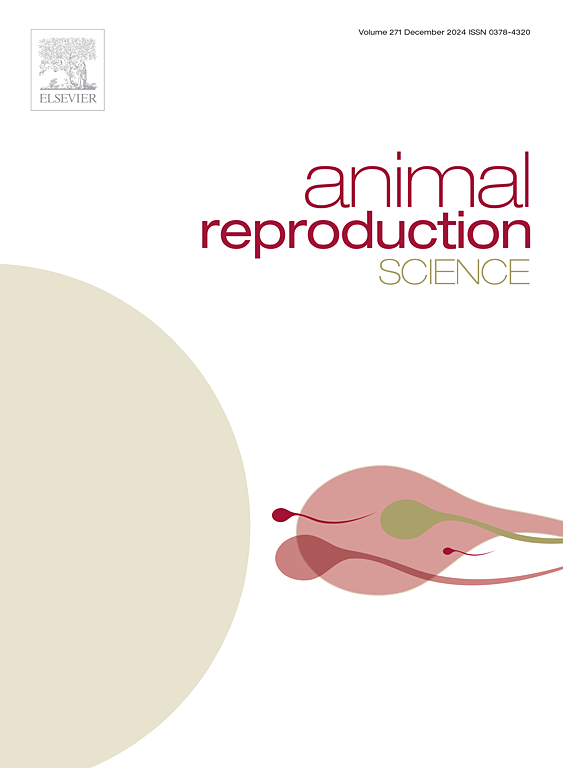长期补充不饱和脂肪酸对荷斯坦小母牛生殖能力及血清和卵泡液代谢谱的影响
IF 3.3
2区 农林科学
Q1 AGRICULTURE, DAIRY & ANIMAL SCIENCE
引用次数: 0
摘要
本研究评估了饲粮中添加大豆籽粒和亚麻籽不饱和脂肪酸120 d对荷斯坦母牛卵母细胞质量、体外胚胎质量和产量以及血液和卵泡液代谢谱的影响。选取24头小母牛,分别饲喂对照饲粮(CON)和添加全生大豆(WRS)或亚麻籽(FLX)的饲粮,以提高粗脂肪含量至约4.5% %干物质(DM)。评估生长性能、血清代谢物、卵泡液成分和体外胚胎产量。对数据进行重复测量分析,模拟治疗、时间及其相互作用的固定效果。通过正交对比(CON vs WRS+FLX和WRS vs FLX)比较治疗方法。与对照组相比,添加组的小母牛平均日增重降低。补充组血清葡萄糖浓度降低,总胆固醇趋于降低,低密度脂蛋白胆固醇趋于升高,表明脂质代谢发生了变化。卵泡液分析显示,补充组甘油三酯降低,尿素水平也有降低的趋势。在补充脂肪的小母牛中,卵母细胞质量得到改善,这表明活卵母细胞的比例更高,但在卵裂率和胚胎产量方面没有观察到差异。这些发现表明,不饱和脂肪酸可以调节荷斯坦小母牛的代谢参数,提高卵母细胞活力,尽管它们对胚胎生产的影响尚不一致。为了提高奶牛的繁殖效率,需要进一步优化脂肪酸补充策略。本文章由计算机程序翻译,如有差异,请以英文原文为准。
Effects of prolonged unsaturated fatty acid supplementation on reproductive competence and metabolic profiles in serum and follicular fluid of Holstein heifers
This study evaluated the effects of a 120-d dietary supplementation with unsaturated fatty acids from soybean grain and flaxseed on oocyte quality, in vitro embryo quality and production, and the metabolic profiles of blood and follicular fluid in Holstein heifers. Twenty-four heifers were assigned to the following treatments: a control diet (CON) and diets supplemented with whole raw soybeans (WRS) or flaxseed (FLX), both formulated to increase ether extract content to approximately 4.5 % dry matter (DM). Growth performance, serum metabolites, follicular fluid composition, and in vitro embryo production were assessed. Data were analyzed as repeated measures modeling the fixed effects of treatment, time, and their interaction. Treatment means were compared through orthogonal contrasts (CON vs. WRS+FLX and WRS vs. FLX). Heifers in the supplemented groups exhibited reduced average daily gain compared to the control group. Serum glucose concentrations were lower, while total cholesterol tended to be lower and low-density lipoprotein cholesterol tended to be higher in supplemented groups, indicating shifts in lipid metabolism. Follicular fluid analyses revealed decreased triglyceride and a tendency to decreased urea levels in supplemented groups. Oocyte quality improved in heifers receiving fat supplementation, as indicated by a higher proportion of viable oocytes, while no differences were observed in the cleavage rates and embryo production. These findings suggest that unsaturated fatty acids can modulate metabolic parameters and enhance oocyte viability in Holstein heifers, although their effects on embryo production remain inconsistent. Further research is needed to optimize fatty acid supplementation strategies for improving reproductive efficiency in dairy cattle.
求助全文
通过发布文献求助,成功后即可免费获取论文全文。
去求助
来源期刊

Animal Reproduction Science
农林科学-奶制品与动物科学
CiteScore
4.50
自引率
9.10%
发文量
136
审稿时长
54 days
期刊介绍:
Animal Reproduction Science publishes results from studies relating to reproduction and fertility in animals. This includes both fundamental research and applied studies, including management practices that increase our understanding of the biology and manipulation of reproduction. Manuscripts should go into depth in the mechanisms involved in the research reported, rather than a give a mere description of findings. The focus is on animals that are useful to humans including food- and fibre-producing; companion/recreational; captive; and endangered species including zoo animals, but excluding laboratory animals unless the results of the study provide new information that impacts the basic understanding of the biology or manipulation of reproduction.
The journal''s scope includes the study of reproductive physiology and endocrinology, reproductive cycles, natural and artificial control of reproduction, preservation and use of gametes and embryos, pregnancy and parturition, infertility and sterility, diagnostic and therapeutic techniques.
The Editorial Board of Animal Reproduction Science has decided not to publish papers in which there is an exclusive examination of the in vitro development of oocytes and embryos; however, there will be consideration of papers that include in vitro studies where the source of the oocytes and/or development of the embryos beyond the blastocyst stage is part of the experimental design.
 求助内容:
求助内容: 应助结果提醒方式:
应助结果提醒方式:


